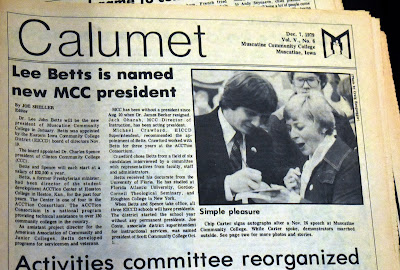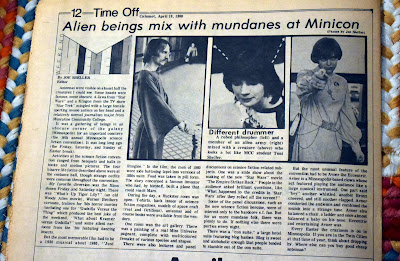 |
| My first news story, and it was on the front page. |
A briefcase found by a family member makes me think of how much has changed and how much has not changed in our media universe in four decades.
The 1979-1980 school year was an interesting one for me. I had graduated from Muscatine High School in 1976, and, at age 17, was an aimless youth with no resources to go to college.
I worked for a year, attended Iowa State University for a year as an engineering major, and then found myself needing a break from the cost and stress of a big state university. I think, although I was not willing to admit it to myself at the time, that the creative side of my personality was deeply unhappy with my life choices, and my decision to return home, get a job at a local factory and attend community college part-time was partly due to an internal struggle that I didn’t fully understand.
To make a long story short, instead of following in my father’s footsteps and attending a big university and becoming a chemical engineer, I ended up taking a journalism writing class during my second quarter at MCC, and then changed my life course.
 |
| Financial drama in the drama department! Well, it seems a bit newsier than "McDonalds to open." |
I decided to become a journalism major, and ended up transferring to a small literal arts college, partly because my original journalism teacher at MCC (shoutout to you, Dennis Stouse) had gotten a job there and was willing to hire me as one of the editors of the weekly student newspaper there.
Recently, one of my younger sisters, Cate, found an old Samsonite brief case, loaded with Calumets, the student newspaper of MCC, from the 1979 and 1980 school years. After looking at its contents, she passed it on to me.
 |
| MCC has a new prez. |
What a trippy experience it was seeing those yellowed old tabloids. There was my first story, written while I was in my intro to newswriting class—a front page news headline screaming about two new chain restaurants opening near campus.
Big news, in retrospect, was not always that big in Muscatine in December of 1978.
In the spring, both my sister and I applied to be on the editorial staff, and we became the editor and campus editor of the Calumet. In the meantime, one of our older sisters had finished her stint in the U.S. Army, and joined us as a student at MCC. The three of us worked hard that year on the paper staff—none harder than Cate, by the way, although the staff we worked with larger than the ones I work with at Mount Mercy University—the late 1970s were a time of greater popularity for studying journalism.
But we had some battles. There were ongoing conflicts with the student senate over something that I’m sure was important at the time, but that I don’t remember all that well. We received some angry letters to the editor from officers of student government.
They didn’t call us fake news, but my entry into journalism came at a time when my personal politics were shifting as the world was also changing. When I was young, Robert Ray was the Republican governor of Iowa, and there was a brand of middle-of-the-road, moderate GOP that I liked.
 |
| My column in 1979 remembering my active participation in the Republican Party in 1976. It was a different world. Do you appreciate the two-part joke that the headline is? |
As a teen, I was a fan of President Gerald Ford, and in 1976, when I was 17, I supported Ford at the Iowa caucuses and as a delegate to the state Republican convention (I could join and be active in the party because I was going to turn 18 and be able to vote that year). It was a little weird reading my 1979 description of that 1976 experience, because the rise of Ronald Reagan and his moral majority brand of more conservative Republican identity was gradually easing me out of the GOP.
I don’t recall if I caucused in 1980, but I’m sure I did not vote for Reagan that fall.
Anyway, the conflict with the student senate and some protests against Iran in the late 1970s foreshadowed the divisive politics we are in today. And although the ties were not yet broken then, I think that the binds of trust between audience and journalist was starting to tear 40 years ago.
I don’t blame journalists for the braking of that trust. Since the Nixon administration, Republicans have discovered that bashing the “liberal” media is an effective strategy. It was not new even them, but as society changed, I think the intensity and level of distrust was on a steady upward trend, and Nixon made it a consistent, main strategy.
And I don’t hold journalists completely blameless, either. Sometimes, urban, college educated editors and reporters can seem out-of-touch and not empathic with those who don’t share all of their values.
This post is not going to offer any solutions. Not that I don’t think about the problem a lot, but I don’t think “lack of trust” is one single issue, nor is it one sided, nor does it negate the important and not always recognized role of morale witness that journalists still fulfill.
And looking back, four decades later, it’s weird to see things seeming so familiar and yet so different. People don’t change as quickly as the world does, and even without smart phone or a world wide web, the passions and conflicts that challenged us in 1980 aren’t so alien today. I suppose that’s a more universal rule. History is worth studying because the world was so different in 1880 that people didn’t conceive of themselves or their reality in the way that we do. But they saw through eyes like ours, felt passions and attempted to be rational using brains that were wired differently by experience but structured the same with human DNA. A lot changed in 40 or 140 years. The species faces novel challenges and needs information about today—news—to manage its adjustment to shifting realities. Yet, we also remain fundamentally the same.
Forty years ago, partly moved by a positive experience with a news story about a steak joint and a McDonalds, I joined the journalism tribe. It was a time of hot wax and copy printed on photo paper that was literally stuck to a page. Any line, any border--well, be careful with those sharp little knives and learn to cut at a 45 degree angle to make neat corners. And corrections! Printing lines of copy. Cut and paste. Anybody seen the clear tape? Layout was more of a commitment back in the day when we weren't nudging text boxes around on computer screens.
Thank you, gods of technology, for InDesign. Some parts of the old days I don't miss so much. Anyway, thanks, Cate, for providing this time capsule of times past. And sisters Cate and Toni—wasn’t that weird time at The Calumet scary and frustrating and fun?
 |
| Ghost of Christmas past, but still, merry Christmas. Don't you love the 1970s typography? |

It was a lot of fun for me to come back from the Army and meet you and Cate as grownups. I enjoyed almost all of it.
ReplyDeleteIt was interesting to get to see a bit of your perspective here, Joe! For me, distrust in the media and has just seemed to be worsening rapidly since 2016, but there’s a fair chance that that’s just when I started paying attention, too. I feel like my parents and grandparents always lament political civility and such, but a lot of people in m generation are just growing up in the dysfunction of the world and adapting as we go. (And a side note: not to knock engineering or anything, but I’m glad you went with journalism. It makes news cycles in the Times office much more enjoyable)!
ReplyDelete